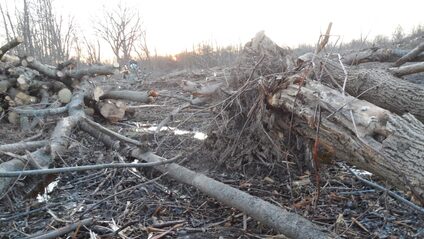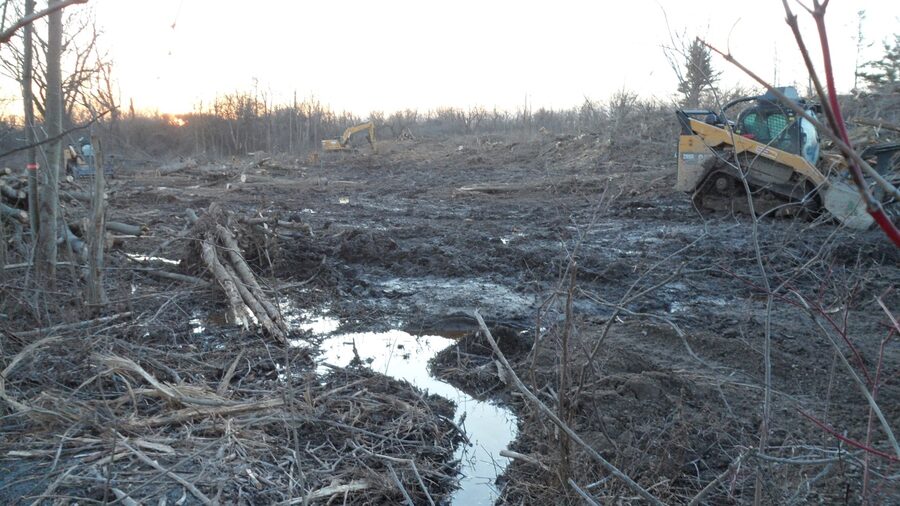
In Memory of Alicja Rozanska.
From John Bacher:
Over the past week and a half, there has been a Carolinian tree massacre by bulldozer underway in Niagara. A preliminary report, completed on August 11, 2021, by Nash Colville of Colville Consulting Inc. provides a rough description of the damage.
The Colville report estimated that 1,375 trees would likely be removed for the Riverfront development. While it called for 554 trees to be retained, it is impossible to determine if this was achieved. The report recommended additional study be completed before a final Tree Saving Plan, required under the Niagara Regional Tree by-law. However, it was accepted by the Region as the final plan. It’s hope for “further assessment of further assessment opportunities for additional tree retention... following the detailed site design” was never carried out.
The trees identified in the Colville report were all native species in good health. They were native species at least 10 centimeters in width, from human breast height (1.37 meters above the ground). Any trees suffering from decline, or which exhibited any signs of infestation from the invasive pest, the Emerald Ash Borer, were excluded from Colville’s count. Nash Colville found that, “With respect to the general health of the trees, no obvious sign of wide-spread disease was present.”
The basic technique of removal by bulldozer is vividly illustrated by photographs of the site. The only trees so far not to have been removed by this technique is a grove of around 40 White Pines. These giants, which are valuable as timber, were cut down.
In their ecological assessment studies on behalf of the developer, GR Investment Group the Savanta consulting firm, diminished the significance of the White Pine grove. This was because of its origins in reforestation efforts in the 1920s, likely by Ontario Hydro, to mitigate some of the damage of their operations in the area from the excavation of a canal.
The White Pine grove in Thundering Waters, like other reforestation projects undertaken under the direction of the Chief Forester of Ontario, Edmund Zavitz, was intended to be a nursery crop to shelter the establishment of a mixed forest (see John Bacher Two Billion Trees and Counting, Dundurn Press, 2011). Before the infamous cut of the day, when over 1,300 trees were cut on March 9, 2022, this restoration was succeeding well. Underneath the towering pines, Pin Oak saplings were shooting forth.
In response to complaints about discussions on Facebook of the Thundering Waters chainsaw-bulldozer massacre, newspapers around Niagara responded with defenses of the cut by Niagara Falls politicians. In essence, they defended the cut based on red paint markings on certain trees to delineate a thirty-meter buffer to safeguard cutting trees from adjacent to protect wetlands. After the cutting was largely completed, fencing was promised to be installed.
The invisible line delineated by paint blobs to guide bulldozers was not the approach recommended by the Colville report to protect retained trees. It recommended that, “A limit of work fence should be erected in the property where anticipated works are to occur in close proximity to trees.” This was sought to establish a “Tree Protection Zone.”
Protected trees under the Colville study were to be marked with “tree wrap to help prevent damage to their trunks during construction.” This was never undertaken.
The Tree Protection Zone envisaged in the Colville report was not envisaged as a straight invisible line. It was supposed to be pushed outwards to protect tree roots. These were supposed to be “flush-cut to protect new tree growth.” There were supposed to be additional expansions to the fenced Tree Protection Zone between 2.4 to 4.2 meters to be determined by the heights of the trees to be safeguarded.
Colville found the dominant species in the lands to be cleared, accounting for 27.5 percent of the trees likely to be removed, were Eastern Cottonwood. Some of these Cottonwoods had quite large diameters. While 22 percent were American Elm, these trees were largely in “good condition.” Twelve percent of the trees were Willow.
While 12.5 percent of the woodland was Green Ash, which might in the future be impacted by the Ash Borer, these trees for now were in good health. Only 5.5 percent of the site was impacted by Buckthorn.
The inventory of the doomed found that 15 percent of the threatened forest were other species. It provided a tragic tombstone of diverse native Carolinian species. These include Black Walnut, Pin Oak, Bur Oak, Swamp White Oak, Red Oak, Black Cherry, Silver Maple, Red Maple and Basswood. Some of the felled trees achieved spectacular heights, notably a Swamp White Oak and American Elm. Such tall Elms are prized as potential seed sources for developing resistant strains against the Dutch Elm disease.
The most surprising revelation in the inventory of the damned was the listing of six wild Honey Locusts, a rare tree in Ontario, all of which were recommended for removal. What makes their inclusion so surprising is that the ecological inventories by the developer, Savanta, have maintained that these species are confined to protected wetlands areas in the Thundering Waters Forest and would not be impacted by the development.
The biggest contrast with the reality of the Colville forest obituary and the delusionary descriptions of Savanta, is its presentation of a healthy, diverse Carolinian woodland on the eve of its destruction. The woodlands dominated by Eastern Cottonwood and Willow, were described by Savanta as heavily occupied by dead and doomed ash and invasive Buckthorn.
Together, Ash and Buckthorn occupied only 18 percent of the woodland, 39.5 percent were Willow and Cottonwood. Here moreover, these species were quite vigorous, growing to often quite magnificent heights and width.
Savanta’s nonsense, which was approved by the same politicians that defended the cut, and the Niagara Peninsula Conservation Authority (NPCA), was most grotesquely expressed in its Woodland Definition Sampling Plot study. A summary of this Big Lie was provided in the March 2018 Riverfront Community Official Plan Environmental Assessment Study Addendum by Savanta. It claimed that “Only two (9%) of the 22 plots meet the definition of woodland based on the reality of healthy, native trees (Cottonwood and Silver Maple).”
Savanta’s weird delusions were repeated in the final EIS study by Savanta for the Riverfront zoning. It claimed that somehow Buckthorn, a mere bush, would overwhelm the mighty Willows and Cottonwoods, “causing it within two to five years” to lose the “canopy/tree density” required to be considered a protected woodland under the Provincial Policy Statement (PPS). This is supposed to guide municipal land use planning decisions under the Planning Act.
Although predicting that most of the Carolinian woodland impacted by the Riverfront Zoning would be destroyed, in his report, Nash Colville expressed the hope that some additional trees would be retained following more detailed information about the development. His report stressed that “estimates (of tree destruction) are considered to be preliminary.” His report “recommended that further assessment of opportunities for additional tree retention be completed following a detailed site design.”
The preliminary tree saving plan by Colville also exposes the delusions behind the work by Savanta which legitimized the official plan and zoning amendments for Riverfront by the Ontario Lands Tribunal. This action is now subject to a request to Leave to Appeal by the Superior Court of Canada. The description of the impacted woodland by Colville affirms the views of experts expected to be called in a future hearing if the Leave for Appeal is successful in that they do constitute a protected woodland under the PPS.
Despite the cutting, if the request for Leave to Appeal is granted and further site alteration remains, the Colville report shows how surviving adjacent forests can naturally reseed the scarred lands. Cottonwoods, Willows, and Black Walnuts are all aggressive early successional species and can restore this rare Carolinian landscape, damaged through cunning and duplicity.

From Danny Beaton:
When I talked to John this morning he was very upset having to write this new article knowing that over 1,300 prime trees were cut down for urban sprawl. He said these people are full of baloney; they are doing things and trying to hide what's most important here.
But long before the Niagara Region allowed this tree cut to begin, I had contacted Niagara Planner Carla Lampman and asked her what was the hurry to allow these machines to start the clearing of life forms that John is concerned with.
As a Mohawk Elder of these territories I am asking you to rethink your position towards environmentalists trying to stop urban sprawl and destruction of our environment. As a Mohawk elder, I would ask you to learn to help environmentalists by educating your staff of the sacredness of all life forms in prime agricultural lands. I'm surprised our people are so tolerant of your planning and green lights for building permits onto vegetation, when climate change and turbulent weather is a threat to human survival.
We all must learn Natural Law and Natural Life supersedes more concrete on Mother Earth or turbulent weather will continue to destroy life which Indigenous People are seeing more and more. Thank you for your consideration in holding off any development until courts are finished. Sincerely Danny Beaton, Turtle Clan Mohawk Nation.
I sent this email March 3,2022 with the subject line Future Tree Removal at Riverfront.
This is our story as we document the destruction of Sacred Mother Earth in the Niagara area and Niagara Fruit Belt area. Basically, we are seeing permits being handed out for profit before Chestnut, Pine, Maple, Willow Trees and more homes of many species are being destroyed with countless good excuses and reasons of why it should be done.
The longer this activity continues the less chance life species have to survive. As a Mohawk I’m thinking, do we Humans deserve to survive and benefit from environmental genocide?
In the Spirit of my Ancestors thank you for listening to me and John. All My Relations.
Photo Credit: Tree Cutting Thundering Waters, 2022.
